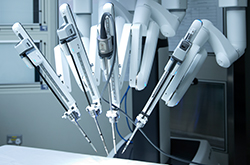Minimally Invasive Surgery Centre
| About Us Contact Us Pamphlet |
| About Us |
Minimally Invasive Surgery Minimally invasive surgery is expected the destiny for all fields of surgery. Instead of opening up big incisions on the body wall to perform surgical operations, minimally invasive surgery uses endoscopes and fine instruments going through small holes on the body wall or natural orifices to effect the same magnitude of operations as in open conventional surgery. What are the Benefits of Minimally Invasive Surgery? For conventional methods, i.e. open surgery, surgeons are required to make large incisions in the body wall during surgery. It often leads to blood loss and severe pain, which means prolonged recovery, long hospital stay and conspicuous scars. Patients may have to rest for one or two months before resuming normal work. The very difference between the conventional and minimally invasive method is "smaller surgical incisions". Smaller surgical incisions mean:
Minimally Invasive Surgery in HKSH The Hospital introduced minimally invasive surgery in early 1990s. It was at first practised in some common and simple operations, e.g. cholecystectomy and ovarian cystectomy. A decade since the introduction, minimally invasive techniques are now adopted in surgeries of different specialties, bringing multitudinous benefits to patients. Research shows that compared to conventional surgery, minimally invasive surgery can achieve the same, and sometimes even better surgical outcomes. The Hospital established the first Minimally Invasive Surgery Centre in Hong Kong in 2003. The Centre was renamed the Surgery Centre in July 2007. In March 2007, the Hospital heralded the new era of robotic surgery by introducing the da Vinci® S Robotic Surgical System, the very first robotic surgical system in Hong Kong's private health sector. With superior 3D visualisation and Endowrist instrument, the da Vinci® S Robotic Surgical System greatly enhances surgical dexterity, precision and control. As a prefect solution to the traditional minimally invasive surgery (whose clinical outcomes are affected by 2D vision and limited hand movements of surgeons), this system brings about unparalleled surgical outcomes). For better coordination of minimally invasive surgical services, the Department of Surgery was established in June 2007 to oversee service provision in the Surgery Centre, Urology Centre, Plastic & Plastic Reconstructive Surgery Centre, ENT & Head & Neck, Paediatrics and Vascular Surgery Clinics. Applications of Minimally Invasive Surgery Today minimally invasive techniques are widely adopted in surgeries of most disciplines with satisfactory outcomes. They include: Laparoscopic Operations:
Endoscopic Treatment of:
Gynaecological Operations:
Interventional Cardiology:
Interventional Radiology (assisted by MRI, CT or Ultrasound) :
Orthopaedic Operations:
Plastic and Reconstructive Surgery:
Thoracic Operations:
Urological Operations:
*This list is far from being exhaustive. For more information, please refer to the websites of respective centres/departments. What is Robotic Surgery - Introducing the da Vinci® S Surgical System  The Hospital is the first hospital in the private sector in Hong Kong to introduce robotically-assisted surgery. Our Hospital purchased and installed the da Vinci® Surgical System to complement our already well-established minimally invasive surgical service. The Hospital is the first hospital in the private sector in Hong Kong to introduce robotically-assisted surgery. Our Hospital purchased and installed the da Vinci® Surgical System to complement our already well-established minimally invasive surgical service.The da Vinci® S Surgical System consists of an ergonomically designed surgeon's console, a patient-side cart with four interactive robotic arms, a high-performance vision system and proprietary Endowrist instruments. Powered by state-of-the-art robotic technology, the surgeon's hand movements are scaled, filtered and seamlessly translated into precise movements of the Endowrist instruments. The da Vinci® S Surgical System has FDA clearance for a wide variety of surgical procedures, including Urology, General Surgery, Gynaecology and Cardiology. Other outstanding features of the da Vinci® S Surgical System include:  Superior visualisation: Incorporating 3-channel vision system, high resolution 3-D image, and panoramic view of the surgical field. Enhanced dexterity, precision & control: Four robotic arms enable solo surgery, fingertip control of instruments, seven degrees of freedom and 90 degrees of articulation, and motion scaling and tremor reduction. Superior ergonomics: Optimal alignment of visual and motor axes, immersive high resolution stereo viewer, and comfortable seated posture. These features enhance surgeons' performance of various surgical procedures, such as dissection and suturing, especially  in areas which are normally difficult in laparoscopic surgery. The System can thus improve clinical outcomes and redefine the standard of care. in areas which are normally difficult in laparoscopic surgery. The System can thus improve clinical outcomes and redefine the standard of care. In mid-December 2006, the Hospital sent a group of four surgeons and four nurses to an Intuitive Training Centre, Hackensack University Medical Centre, New Jersey, the United States for the da Vinci® S Surgical System Training. In mid-January 2007, another two surgeons received the same training at the Intuitive Surgical Headquarters in Sunnyvale, California. They completed the training successfully and were certified to perform and assist in robotically-assisted operations. In February the same year, on-site training for nurses of our Operating Theatre was provided by trainers from Intuitive. This is to ensure all our staff members are well trained before we start to use the System. Beyond Minimally Invasive On 1st November, 2007, the Hospital introduced the state-of-the-art MR Guided Focused Ultrasound for treatment of uterine fibroids. This is an outpatient procedure which is non-invasive, effective and does not require surgical incisions, anaesthesia or hospitalisation. The procedure uses Magnetic Resonance Imaging to provide 3D imaging of the uterus without exposure to radiation. The gynaecologist is able to "see" inside the abdomen of the patient to pinpoint, guide and continuously monitor the treatment process to ensure the destruction of the fibroid tissue, without affecting the surrounding normal tissue. |











